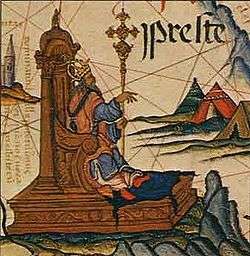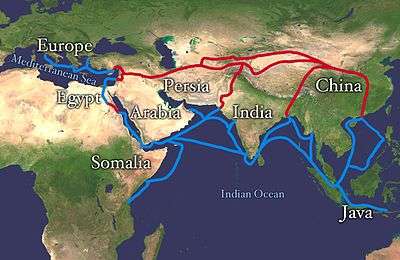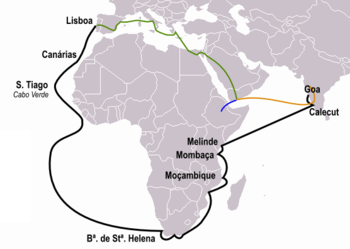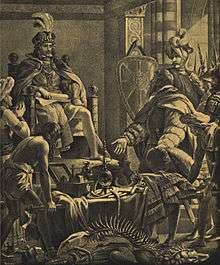The Portuguese discovery of the sea route to India
The discovery of the sea route to India is the description sometimes used in Europe and among the Portuguese for the first recorded trip made directly from Europe to India via the Atlantic Ocean. It was undertaken under the command of Portuguese explorer Vasco da Gama during the reign of King Manuel I in 1497 -1499. Considered by Europe to be one of the most remarkable voyages of the Age of Discovery, it consolidated the Portuguese maritime presence and that's country dominance of global trade routes.
Preparations of the trip
The plan for working on the sea route to India was charted by Portuguese King John II as a cost saving measure in the trade with Asia and also an attempt to monopolize the spice trade. Adding to the increasingly influential Portuguese maritime presence, John II craved for trade routes and for the expansion of the kingdom of Portugal which had already been transformed into an Empire. However, the project would not be realized during his reign. It would be his successor, King Manuel I, who would designate Vasco da Gama for this expedition, while maintaining the original plan.
However, this development was not viewed well by the upper classes. In the Cortes de Montemor-o-Novo of 1495 an opposite view was visible over the journey that John II had so painstakingly prepared. This point of view was contented with the trade with Guinea and North Africa and feared the challenges posed by the maintenance of any overseas territories, and the cost involved in the launching and maintenance of sea lanes. This position is embodied in the character of the Old Man of Restelo that appears in Os Lusíadas of the Portuguese epic poet Luís Vaz de Camões, who opposes the boarding of the armada.
King Manuel did not share that opinion. Keeping the D. João II plan, he went ahead to equip the ships and chose Vasco da Gama as the leader of this expedition and the captain of the armada. Interestingly, according to the original plan, John II had appointed his father, Stephen da Gama, to head the armada; but by the time of implementing the plan, both were deceased.
This global expedition was launched on 8 July 1497. It would conclude two years later with the entry of the ships back into the river Tagus, bringing with them the good news that bestowed on Portugal a prestigious maritime position.
The Context


Spices were always been considered to be the gold of the Indies. Cinnamon, ginger, cloves, pepper and turmeric had long been products which were difficult to obtain in Europe, which was brought in by caravans and experienced merchants coming from the East.
A merchant of Lisbon describes the overland spice route as follows: Only the markets of Venice and Genoa then scattered these spices all over Europe, great in cost, and without guaranteed arrival. In 1453, with the capture of the city of Constantinople by the Ottomans, the trade of Venice and Genoa reduced to a great degree. The advantage of the Portuguese to establish a sea route therefore virtually free of assault - however, covered in perils in the sea - showed itself rewarding and outlined a large income to the Crown in the future. Portugal would directly link the spices producing regions to their markets in Europe.
Around the year 1481, João Afonso of Aveiro, attempted to undertake an exploration of the kingdom of Benin, and gathered information about an almost legendary prince Ogané, whose kingdom was located far to the east of Benin. He was thought to be Christian and one who enjoyed great respect and power. It was said the Benin kingdom where Ogané had his headquarters was twenty moons away in distance, which, according to the account of João de Barros, correspond to two hundred fifty leagues.

Excited with this news, John II sent in 1487, Frei António de Lisboa and Pedro de Montarroio to locate in the East new information that could find Prester John, which seemed to correspond, after all, to the description that came about the prince Ogané. But the mission of those sent was merely to Jerusalem, because these two Portuguese were unaware of the Arabic language and hence feared to continue, and instead returned to Portugal.
Very carefully and secretly two young men of trust were prepared. They were: Afonso de Paiva, of Castelo Branco, and Pêro da Covilhã. They began their journey and went through Valencia, Barcelona, Naples, Rhodes, Alexandria, Cairo and Aden. Here their paths separated: Afonso de Paiva headed to Ethiopia and Pêro da Covilhã to India. None of the men returned, but the information needed by D. John was brought back to the kingdom, and with this came the support base to serve the possible epic maritime adventure that lay ahead.
The travel plan then would have predicted the safety of the route. For this, it would be necessary to install trading posts along the way, and build fortresses. The mission would be up to the captain of the armada who was provided with many gifts and equipment to brave the seas and diplomatic credentials and perseverance to create links with unknown monarchs who eventually were found the way.
But it would no longer be in the reign of King John II of Portugal that this project, which was already facing a strong opposition from the court, would be initiated. It would only happen in the time of his successor, King Manuel I who incidentally did not share the general opinion about the sea routes being a good - if not the best - means to dominate trade with the East.
The navy

Among the sailors, were two interpreters Fernão Martins and Martim Afonso de Sousa, and two brothers, João Figueira and Pêro da Covilhã. In all, the crews comprised 170 men.
The sailors had sailing charts marked with the positions of the African coast known until then, quadrants, astrolabes of various sizes, tables with calculations - such as astronomical tables of Abraham Zacuto -, needle and bobs. One of the ships was carrying groceries sufficient for three years: biscuits, beans, dried meats, wine, flour, olive oil, pickles and other items of pharmacy. Also planned were continuous replenishment along the coast of Africa. The trip to India was performed by three ships and another ship that carried supplies. These three ships had a captain and a pilot. The ship of groceries had only a captain. Two ships also had a scribe or writer. The first ship had a master.
The voyage

Thus began the expedition on 8 July 1497. The Lisbon shipping line to Cabo Verde was the usual one and the Indian Ocean is described by Álvaro Velho thus: "The coastal route until Malindi and direct passage from this port to Calicut". During this expedition, the latitudes were determined by solar observation, as stated by João de Barros.
Reports of the Daily Board (Diários de Bordo) of the ships note many unique experiences. Also found were a rich flora and fauna. Contact was made near the bay of St. Helena with tribes who ate sea lions, whales, gazelle meat and herbal roots; They walked covered with fur and their weapons were simple wooden spears of Zambujo and animal horns; They saw tribes who played rustic flutes in a coordinated manner, which was surprising a the sight for the Europeans. Scurvy (vitamin C deficiency) affected the crew. They crossed into Mozambique with palm trees yielding coconuts.
Despite the adversities of a trip of this scale, the crew retained their curiosity and courage to achieve the feat and get along with people they encountered. To gather pace, they raided ships in search of pilots. With the prisoners, the Captain-General could trade, or put them to work.
It is known, thanks to the Portuguese humanist philosopher Damião de Góis, that during the trip five monuments were set in place. San Rafael, in the Bons Sinais river; São Jorge, in Mozambique; the Holy Spirit in Malindi; Santa Maria, in Ilhéus, and San Gabriel, in Calicut. These monuments were meant to affirm the Portuguese sovereignty in these places so that other explorers who arrived later did not take the land for themselves as discoveries.
Arrival in Calicut
On May 17, 1498, the fleet reached Kappakadavu, near Calicut, in the current Indian state of Kerala, thus having established the route via the Indian Ocean and managing to open the sea route from Europe to India.
Negotiations with the local governor, Samutiri Manavikraman Raja, Zamorin of Calicut, were difficult. Vasco da Gama's efforts to obtain favorable commercial terms have been hampered by the different cultures and the low value of their gifts—in the West it was customary for kings to offer presents to the foreign envoys; in the East the kings were expected to be impressed with rich offerings. Goods presented by the Portuguese proved insufficient to impress the Zamorin and representatives of the Zamorin mocked their offers, while the Arab merchants established there resisted the possibility of unwanted competition.
Vasco da Gama's perseverance made him nevertheless initiate negotiations between him and the Zamorin, who was pleased with the letters of King Manuel I. Finally, Vasco da Gama managed to get an ambiguous letter of concession rights to trade, supporting the meeting saying:
The Portuguese eventually were able to sell their goods at a low price in order to acquire small amounts of spices and jewels to take to their kingdom. However the fleet eventually departed without warning after the Zamorin and his naval chief Kunjali Marakkar insisted that they left all their assets as collateral. Vasco da Gama kept his goods, but left a few Portuguese with orders to start a trading post.
Back in Portugal

On July 12, 1499, after more than two years since the beginning of this expedition, the caravel Berrio entered into the river Tagus, commanded by Nicolau Coelho, with the news that would thrill Lisbon: the Portuguese had finally reached India by sea. Vasco da Gama had fallen behind on Terceira Island, preferring to stay on with his brother who was seriously ill, thus foreclosing the celebrations and congratulations by the news.
Of the ships involved, only the São Rafael (St. Raphael) did not return. It was burnt due to its inability to maneuver, as a result of the reduced number of the crew as a result of diseases which killed about half the crew, such as scurvy (vitamin C deficiency), which was felt acutely while crossing the Indian Ocean. Only 55 of the 148 men who were part of the armada survived the trip.
Vasco da Gama returned home on 29 August and was received by King Manuel I with contentment. He assigned him the title of Don and great rewards.
Manuel I hastened to break the news to the kings of Spain, both as a display of pride as also to warn that both the routes would now explored by the Portuguese Crown.
There is news of an Italian merchant who spread the good news in Florence.
The merchant refers to Melinde.
With the opening of the sea route to the East Indies, the Venetians, who controlled the trade of the Mediterranean, would buy pepper from the Portuguese, at half the price they paid to the Arabs in Egypt. The fall of the Venetian monopoly on the spice trade in Europe and the resulting drop in prices of spices contributed to the commercial development of the continent.